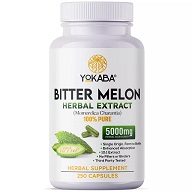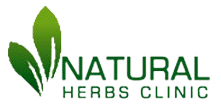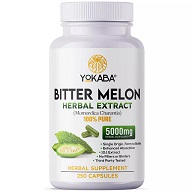Bitter Melon 5000mg Herbal Extract by Yokaba: A Powerful Health Supplement

Overview of Bitter Melon
Bitter melon, scientifically known as Momordica charantia, is a tropical fruit widely known for its distinct, bitter taste and remarkable health benefits. Used for centuries in traditional medicine, this green, bumpy fruit has been a staple in Ayurvedic and Chinese healing systems. Bitter melon contains a wealth of vitamins, minerals, and beneficial compounds, making it a popular choice among those looking for natural ways to enhance health and wellness.
The Bitter Melon 5000mg Herbal Extract by YOKABA provides a potent dose of this remarkable fruit in a convenient, easy-to-take form. Made from high-quality bitter melon extract, each capsule is designed to support metabolic, digestive, and immune health. The key benefits of Bitter Melon Extract, its recommended usage, and how it can fit into a wellness routine.
Key Benefits of Bitter Melon Extract
Blood Sugar Regulation
One of the most notable benefits of bitter melon is its ability to help regulate blood sugar levels. The fruit contains compounds that act similarly to insulin, helping cells absorb glucose and maintain steady blood sugar levels. Studies have shown that bitter melon extract may help lower blood glucose levels, making it a popular choice for individuals with blood sugar management concerns.
Rich in Antioxidants
Bitter melon is packed with powerful antioxidants that combat free radicals, which can cause cellular damage and accelerate aging. Antioxidants like vitamin C, flavonoids, and phenolic compounds help protect the body from oxidative stress, promoting healthier skin, reducing inflammation, and supporting overall immune function.
Supports Digestive Health
Bitter melon contains fiber, which aids in digestion and helps prevent constipation. The extract also has properties that support a balanced gut microbiome, aiding in the digestion and absorption of nutrients. Its ability to cleanse the liver and support bile production makes it a valuable Simple Natural Supplements for digestive health.
Anti-Inflammatory Properties
Chronic inflammation is a common factor in many health issues, including joint pain, skin conditions, and heart disease. Bitter melon’s anti-inflammatory compounds may help alleviate inflammation, offering natural support for those with inflammatory conditions.
Promotes Weight Management
Bitter melon is low in calories but rich in nutrients, making it an excellent addition to weight management routines. The fruit’s potential to regulate blood sugar levels can also reduce food cravings, while its fiber content helps promote a feeling of fullness, aiding in weight control.
Bitter Melon 5000mg by YOKABA: Product Highlights
The Bitter Melon 5000mg Herbal Extract by YOKABA is specially formulated to deliver the full benefits of bitter melon in a concentrated form. Each capsule contains 5000mg of bitter melon extract, ensuring a potent dose that allows users to experience its effects without needing to consume large amounts of the fruit.
- High Potency: With 5000mg per capsule, this product offers a concentrated dose of bitter melon for maximum efficacy.
- Convenience: Unlike raw bitter melon, which has a strong, bitter taste, these capsules provide all the benefits in an easy-to-swallow, tasteless form.
- Quality Assurance: YOKABA is known for its high manufacturing standards, using only premium-grade ingredients to ensure purity and potency.
Recommended Usage
For adults, the typical recommended dosage is one capsule daily with a meal, or as directed by a healthcare professional. It’s essential to follow recommended dosages, as excessive intake of bitter melon can lead to unwanted side effects.
Who Can Benefit from Bitter Melon 5000mg by YOKABA?
Best Organic and Supplements Vitamins may be beneficial for individuals interested in:
- Supporting healthy blood sugar levels
- Boosting immune health and antioxidant intake
- Improving digestive health
- Reducing inflammation naturally
- Managing weight through balanced blood sugar levels and enhanced digestion
Safety and Precautions
While bitter melon is generally safe for most people, pregnant and breastfeeding women should avoid it due to its potential to stimulate the uterus. Additionally, those with blood sugar management concerns or who take diabetes medication should consult their healthcare provider before adding bitter melon to their regimen, as it can amplify the effects of blood-sugar-lowering medications.
Conclusion
The Bitter Melon 5000mg Herbal Extract by YOKABA offers a natural, powerful solution for those seeking a high-potency supplement with multiple health benefits. From blood sugar regulation to supporting digestion and immune health, this bitter melon extract is a valuable addition to any wellness routine. With YOKABA’s commitment to quality and potency, users can confidently enjoy the health benefits of bitter melon in a convenient and effective from.





